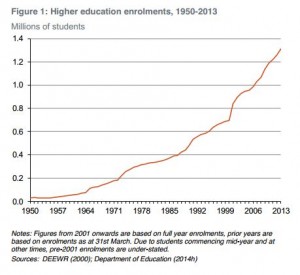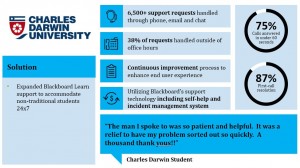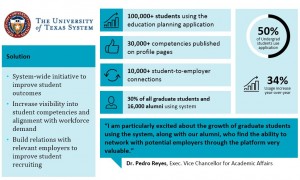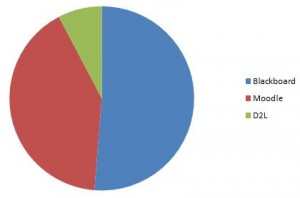Last week I attended the 2015 NACADA International Conference hosted by The University of Melbourne and the theme of the conference was “Partnering for Student Success”.
The conference was an opportunity to present a paper on other aspects of Blackboard products and services (Student Lifecycle Services, myEdu and Transact) that impact on the student experience at Higher Education (HE) institutions.
When we look at what students expect from their HE experience we find that excellence in teaching and supervision is at the core but other factors include preparation for a job/career; a sense of attachment and kinship with their learning community; a highly mobile experience, accessible anywhere/anytime and technology and facilities that simply work all the time.
This broad ecosystem has become increasingly important for student success as HE institutions are operating in an increasingly competitive environment with diminishing resources against a backdrop of the massification of HE (see fig. 1 – Australia) and the new norm of the non-traditional student enrolled in HE (see fig. 2 – USA) in western countries.
To support this broad ecosystem, Blackboard has products and services that extend beyond the Learn/Moodlerooms LMS’s and associated applications such as Collaborate, Learning Analytics and Mobile.
These include the areas I spoke about in my presentation entitled “Blackboard – more than an LMS”; namely:
1. Student LifeCycle Services
This includes a range of professional services supported by custom software solutions to reduce barriers for students during their HE experience from their enrolment through all their support needs (by providing a virtual 365/24/7 one-stop-shop with access to a “single source of truth”) to graduation by providing a service as either a replacement for, or supplement to, the institution’s on-campus resources.
In Australia, Charles Darwin University (CDU) is our first client using ‘Student LifeCycle Services’ and initially it is for the provision of support for the Blackboard Learn application.
2. myEdu
This is an interesting application particularly with the increasing emphasis on work-integrated learning, ‘job ready’ graduates and employability in a highly competitive job market.
The core goal of myEdu is helping young people to manage their academic careers in a way that improves their chances of getting a job – plain and simple. This has been very successful in the United States and we’re now looking to localise this product for the Australian marketplace (if you’re from an Australian HE institution and you’re interested in partnering with Blackboard I’d love to hear from you!).
3. Blackboard Transact
This includes a comprehensive suite of commerce and security solutions built for HE and has been serving the North American HE sector for over 20 years and today there are over 1,000 clients with more than 6.5M electronic student ID’s issued, more than 9.7B student purchase transactions processed annually, and more than 5.0B door access authentications annually.
Again, this is a product that has been brought to Australia in 2015 and The University of Sydney is our first client.
The aim is to make campus life enjoyable and secure for all students and staff through the use of a credentialing system that can include the use of contactless NFC technology in today’s smartphones.
Conclusion
It is a truism that student retention, success, development and engagement are affected by many factors and HE institutions are able to influence some of these in the complex ecosystem that is the Student Experience. Blackboard recognises that this extends beyond the traditional LMS and through products and services mentioned above is able to partner with institutions to attract, enrol and welcome new students, to help in them staying and finding meaningful careers and be references for future students.
Sources:
Fig 1. taken from “Mapping Australian Higher Education, 2014-15” by Andrew Norton, Grattan Institute – http://grattan.edu.au/report/mapping-australian-higher-education-2014-15/
Fig 2. taken from “America as 100 College Students”, Melinda and Bill Gates Foundation – http://postsecondary.gatesfoundation.org/student-stories/america-as-100-college-students/




